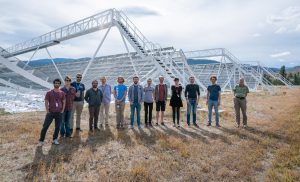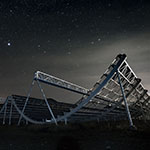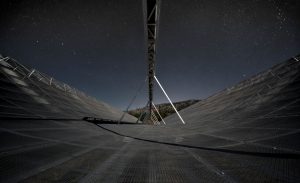Observations quadruple the number of known radio bursts and reveal two types: one-offs and repeaters.
Written by Jennifer Chu, MIT News Office
To catch sight of a fast radio burst is to be extremely lucky in where and when you point your radio dish. Fast radio bursts, or FRBs, are oddly bright flashes of light, registering in the radio band of the electromagnetic spectrum, that blaze for a few milliseconds before vanishing without a trace.
These brief and mysterious beacons have been spotted in various and distant parts of the universe, as well as in our own galaxy. Their origins are unknown, and their appearance is unpredictable. Since the first was discovered in 2007, radio astronomers have only caught sight of around 140 bursts in their scopes.
Now, a large stationary radio telescope in British Columbia has nearly quadrupled the number of fast radio bursts discovered to date. The telescope, known as CHIME, for the Canadian Hydrogen Intensity Mapping Experiment, has detected 535 new fast radio bursts during its first year of operation, between 2018 and 2019.
Scientists with the CHIME Collaboration, including University of Toronto researchers at the Dunlap Institute for Astronomy and Astrophysics, David A. Dunlap Department of Astronomy and Astrophysics, Canadian Institute for Theoretical Astrophysics and Department of Physics, have assembled the new signals in the telescope’s first FRB catalog, which they will present this week at the American Astronomical Society Meeting.
The new catalog significantly expands the current library of known FRBs, and is already yielding clues as to their properties. For instance, the newly discovered bursts appear to fall in two distinct classes: those that repeat, and those that don’t. Scientists identified 18 FRB sources that burst repeatedly, while the rest appear to be one-offs. The repeaters also look different, with each burst lasting slightly longer and emitting more focused radio frequencies than bursts from single, nonrepeating FRBs.
These observations strongly suggest that repeaters and one-offs arise from separate mechanisms and astrophysical sources. With more observations, astronomers hope soon to pin down the extreme origins of these curiously bright signals.
“Before CHIME/FRB, only a few dozen FRBs had been discovered,” explains CHIME/FRB member Keith Vanderlinde, Associate Professor at University of Toronto’s David A. Dunlap Department of Astronomy & Astrophysics and the Dunlap Institute for Astronomy & Astrophysics. “Now we’ve got a much bigger catalog to work with — which helps us work out what exactly is causing these bursts, and how they might help us understand the wider Universe.”
Seeing flashes
CHIME comprises four massive cylindrical radio antennas, roughly the size and shape of snowboarding half-pipes, located at the Dominion Radio Astrophysical Observatory in British Columbia, Canada. CHIME is a stationary array, with no moving parts. The telescope receives radio signals each day from half of the sky as the Earth rotates.
While most radio astronomy is done by swiveling a large dish to focus light from different parts of the sky, CHIME stares, motionless, at the sky, and focuses incoming signals using a correlator — a powerful digital signaling processor that can work through huge amounts of data, at a rate of about 7 terabits per second, equivalent to a few percent of the world’s internet traffic.
“This is what really sets CHIME apart,” explains Vanderlinde. “This backend, along with CHIME’s unique design, allows us to see simultaneously in a thousand different directions, and to find FRBs so many times faster than other telescope.”
Over the first year of operation, CHIME detected 535 new fast radio bursts. When the scientists mapped their locations, they found the bursts were evenly distributed in space, seeming to arise from any and all parts of the sky. From the FRBs that CHIME was able to detect, the scientists calculated that bright fast radio bursts occur at a rate of about 800 per day across the entire sky — the most precise estimate of FRBs overall rate to date.

Some members of the CHIME/FRB Collaboration, in front of CHIME in 2019. Courtesy: Andre Renard, Dunlap Institute.
“If our eyes were capable of detecting radio radiation we could see FRBs all the time in our skies, happening in any direction,” explains CHIME/FRB member Tomás Cassanelli, a PhD student at the University of Toronto’s Dunlap Institute for Astronomy & Astrophysics and the David A. Dunlap Department for Astronomy and Astrophysics. ”We had to wait many years until technology could help us see these events, even though they are happening all the time.”
Mapping the Universe
As radio waves travel across space, any interstellar gas, or plasma, along the way can distort or disperse the wave’s properties and trajectory. The degree to which a radio wave is dispersed can give clues to how much gas it passed through, and possibly how much distance it has traveled from its source.
For each of the 535 FRBs that CHIME detected, Masui and his colleagues measured its dispersion, and found that most bursts likely originated from far-off sources within distant galaxies. The fact that the bursts were bright enough to be detected by CHIME suggests that they must have been produced by extremely energetic sources. As the telescope detects more FRBs, scientists hope to pin down exactly what kind of exotic phenomena could generate such ultrabright, ultrafast signals.
Scientists also plan to use the bursts, and their dispersion estimates, to map the distribution of gas throughout the Universe.
“Thanks to FRBs traveling from distant places to the Earth, we can measure their interaction with matter along the way,” Cassanelli says. “This data can help us to better understand the evolution of the Universe as a whole.”
With lots of work ahead, the CHIME/FRB collaboration agrees that this discovery is worth celebrating. Explains CITA Professor Ue-Li Pen: “These wonderful results are the fruits of the persistent efforts from the CHIME and FRB teams over the past 15 years.”
This research was supported by various institutions including the Canada Foundation for Innovation, the Dunlap Institute for Astronomy and Astrophysics at the University of Toronto, the Canadian Institute for Advanced Research, McGill University and the McGill Space Institute via the Trottier Family Foundation, and the University of British Columbia.
For more information, please contact:
Meaghan MacSween
Communications and Multimedia Officer
Dunlap Institute for Astronomy & Astrophysics,
University of Toronto
meaghan.macsween@utoronto.ca
Abby Abazorius,
MIT News Office
abbya@mit.edu;
617.253.2709
The Dunlap Institute for Astronomy & Astrophysics at the University of Toronto is an endowed research institute with more than 90 faculty, postdocs, students and staff, dedicated to innovative technology, ground-breaking research, world-class training, and public engagement. The research themes of its faculty and Dunlap Fellows span the Universe and include: optical, infrared and radio instrumentation; Dark Energy; large-scale structure; the Cosmic Microwave Background; the interstellar medium; galaxy evolution; cosmic magnetism; and time-domain science. The Dunlap Institute for Astronomy and Astrophysics, David A. Department of Astronomy & Astrophysics and the Canadian Institute for Theoretical Astrophysics comprise the leading centre for astronomical research in Canada, at the leading research university in the country, the University of Toronto.



